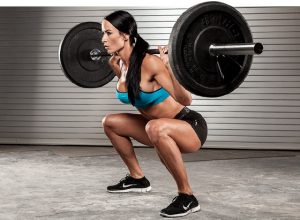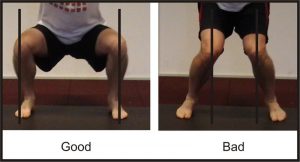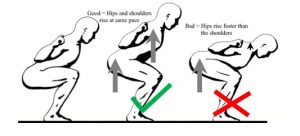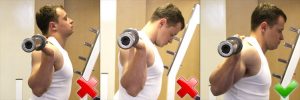Classical errors
I read a Nerd Fitness article and I learned good stuff.
Click here to read Part 1 and Part 2
Squat is a movement that we make since baby, it’s a basic movement. But when I started to do squat with weight, I make mistakes and I’m going to talk about the classical mistakes we make when we’re newbies.
Put all the weight on your toes
You need to have your heels glued to the floor throughout squat. This is important for spreading your bodyweight and weights on the barbell.
You also distribute part of the weight on the balls of your feet but it’s not the total weight. You should be able to move your toes in all directions during the squat.
The total weight (your bodyweight + weight on the barbell) is divided between the ball of your fee and your heels.
Don’t squat down too low
Your squat should go down at least until your hips joint are below your knee (parallel).
Maybe you have a special training that asks you to make a lower squat, it’s up to you to see. But making a parallel squat is enough to work your muscles well.
When you do a partial squat , so you have a squat above the parallel, you’ll work more your quadriceps than your hamstrings, in addition you put a lot of stress on your knees. The more you squat down, the less pressure you put on your knee.
Very, very often, people make a connection between squat and knee problems. Unfortunately, it’s a negative myth, a lie that makes people afraid of squat. For exemple, a gym member saw me with my knee wrap and said : « Be careful when you squat, you’re going to hurt yourself ! ». But does he know that my knee wrap increase my squat’s performance by 5-10 % ? I don’t think so. Here are some interesting articles here and there .
The more you squat down, the more you work your glutes. But when we squat down, we have to go back up. And more we go down and more it’s harder to go up (strength and flexibility). The squat in parallel (your hips joints below your knee), it’s enough.
If you have trouble to squat down at the parallel, it could have several causes : little mobility to your ankles, to your hip flexor or your hamstrings ; weak glutes ; poor pelvic alignment (among many other things).
Knee position
To do a good squat, you must have your knees aligned with your toes. As the body of every human being is unique, the position is slightly different from one person to another but your knees shouldn’t be too much outside or too much inside. Your knees are more or less in the center.
Back position
During the whole squat, you need to have your torso up and your shoulders back. This position allows you to have your spine in a « neutral » position. This avoids having your back in hyper extend and not having your shoulders rounded forward.
Head position
There are people (even personal trainers) who will tell you to look up or down. Let’s test it right away with an anatomical version.
When you look at the ceiling, your cervical spine is in an unsecured position and when you add weight, it becomes dangerous. Look at the ground is not better.
You need to have your head in a « neutral » position. To be able to do this, look straight in front of you. Focus on a point in front of you so that you’re able to hold a tennis ball between your chin and your torso.
Too much weight on heels and inside/outside of the feet
Often, when we’re beginners, we are so focused on putting the weight on the heels and having a good position with the knees we forget to keep the ball on the floor. You need to divide some of the total weight on the ball of the feet because it’s very difficult to keep the balance when all the weight is on your heels.
It’s the same for the inside or outside of your feet. As you put the total weight on your heels, you try to keep balance with the inside and outside of your feet. Keep the ball of your feet on the floor to distribute part of the total weight and it will be easier to keep the balance.
Complex
Don’t worry, I also had difficulties to do a squat with a good technique. I’ll explain to you something I used to learn the technique. Using a box or a bench is also useful for people who have knee problems and can no longer do bodyweight squat.
Using a box/bench is great for learning to squat down by distributing well the total weight between the ball of your feet and your heels rather than on your knees and toes.
Find a box/bench that allows you to be in parallel with your squat when you’re sitting on it.
The lower the box/bench is, the more it will help you to have stronger hips. If the box/bench is exactly parallel, it will help you to have stronger quadriceps. If you’re a squat beginner, don’t worry, a box/ bench at the right height for you to be in parallel or a little below when you squat down is perfect.
Let’s go to do bodyweigth squat. Put the box/bench behind you and do one step forward.
Inspire, throw your butt back, keeping your knees aligned with your toes and squat down until your sit completely on the box/bench. Keep your body contracted and control movement.
When you seated, don’t move and study your position. Is your back and core contracted ? Is the total weight distributed between the ball of your feet and heels ? Is your head in a neutral position ? Once you answered these questions, you can get up by using you hips up. Don’t shift the weight forwards on your toes to help you get up. Use your heels, keep your shoulders back with your chest up and keep your knees aligned with your toes.
After some sets, you’ll understand how to better use your body and you’ll be able to make the movement in a fluid way.
You’ll know when you’re doing a good squat. This is when you’re in the low position of squat and when you get up, you don’t swing forward but you put the weight on your heels.
Long life to squat
Squat is cool
Ok, the majority of people say that squat is bad for knees but the truth is that it’s the safest movement and one of the best to improve your knees health (when the squat is done with a good technique). This help to strengthen your knees, improve your stability and reduce the risk of injury. This is valid for people over 60 years old.
If you already have a knee problem or have pain with squat and think your do squat with a good technique, you need to see a doctor or a physical therapist to check your knees.
What are your difficulties when you try squat ?
Share this article if you think it can help someone you know. Thank you.
-Steph




